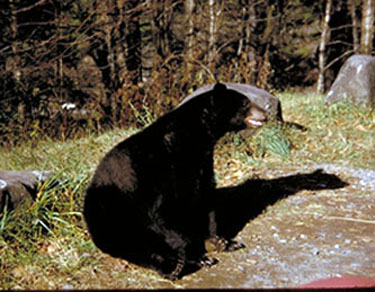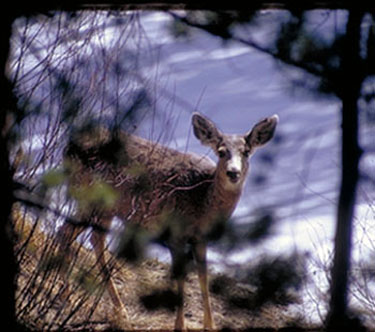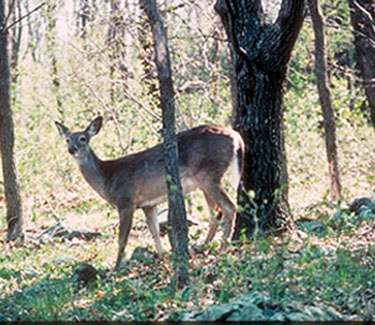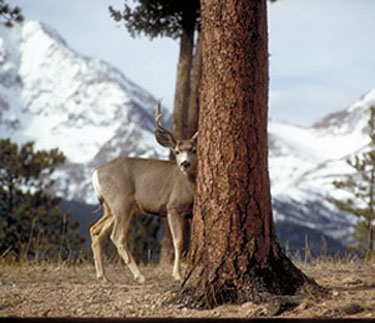
Hunting prohibited, but poachers try
Federal law prohibits hunting and the possession of weapons within any of the national parks.
However, that does not stop people from attempting to kill wildlife anyway.
“We do have a poaching problem in the park,” said Karen Beck-Herzog, public affairs officer for Shenandoah National Park in Virginia “Mostly concerning the deer and bear population.”
Shenandoah, in conjunction with the Virginia Dept. of Game and Fisheries conducted an investigation on bear poaching in recent years. They were able to trace the sale of bear gall from the United States to Korea. “There is a large black market for bear gall,” Herzog said.
 |
A black bear poses for photographers at Great Smoky Mountains National Park (Photo courtesy of the National Park Service). |
Bears have very large gall bladders that produce large amounts of bile. The bile is used frequently in Asian medicine as a cure for various ailments. It is believed that the bile can cure problems such as high blood pressure, jaundice, heart disease, fever, headaches, tooth decay and a range of other health problems. In Asia, a dried up black bear’s gall bladder sells for about $1,000.
Although hunting within the national parks is not permitted, there are areas outside the parks where hunting is legal. Most of the parks are surrounded by state or private owned land. State land is open for hunting and private landowners have the choice to either allow or disallow hunting.
According to the Code of Federal Regulations for Great Smoky Mountains National Park, “Game animals lawfully taken outside of Great Smoky Mountains may be transported by vehicle through the park.” In order to transport these animals however, you may only use certain roads and they must be transported under certain conditions.
Many parks allow transportation through the park of animals legally hunted outside the park. There are, however, certain rules that must be followed, including a permit that states you have the right to be transporting the animal.
According to an article by the National Association of Tribal Historic Preservation Officers, “While the National Park Service does not keep comprehensive statistics on how much poaching occurs in its nearly 400 parks, its 2006 budget request reported that thefts have helped spur the decline of at least 29 wildlife species.”
Despite the fact that hunting is barred, some parks are facing the problem of out- of-control large animal populations.
Recently, U.S. Rep. Mark Udall of Colorado introduced a bill that would allow hunting in the Rocky Mountain National Park in his home state in order to take care of the growing elk population.
| A deer is surprised as it searches for food in Rocky Mountain National Park in Colorado (Photo courtesy of the National Park Service). |  |
Officials are considering a supervised and limited hunt to take care of the issue.
Many people, however, are worried that allowing Rocky Mountain National Park to do this and that changing a 78-year-old federal law, would encourage more parks to do the same.
One of the key opponents is the group In Defense of Animals. The IDA is constantly fighting for the protection and fair treatment of animals. Its campaigns range from animal abuse in Korea to puppy mills to fur.
The organization is currently heading a campaign to oppose the introduction of elk hunting in Rocky Mountain National Park. The group asks everyone that visits its website to sign a statement saying, “Allowing private citizens to shoot animals in a national park would violate the mission of our national park system: to provide refuge for wildlife where people can enjoy the wonders of nature in peace and safety.”
IDA suggests that, instead of allowing private citizens to hunt, wolves should be brought in as natural predators and the hunting or culling which means shooting, should be done only by trained park employees.
According to the IDA, many Rocky Mountain National Park staff members disagree with Rep. Udall’s bill. The officials are looking into allowing culling, but are not allowed to bring in wolves due to a prohibition by the Colorado Division of Wildlife.
There are serious penalties that can befall those who violate the parks no hunting policy.
| Deer, such as this one in Shenandoah National Park in Virginia, are common in many U.S. national parks (Photo courtesy of the National Park Service). |  |
Those who infringe on the guidelines are violating several laws in Shenandoah’s Code of Federal Regulations and are subject to numerous penalties.
The lowest offense violates orders 36 CFR 2.2 and CFR 2.4 in the Code of Federal Regulations. This order is from the Dept. of Interior, which oversees the National Park Service. According to 36 CFR, violators will be subject to a maximum of a $5,000 fine and/or six months in jail.
If a person takes an animal against state or federal rules, they are violating the Lacey Act.
The Lacey Act was designed in order to give the Dept. of Interior the right to develop procedures that will help in restoring types of wildlife in areas of the U.S. in which they have become scarce or extinct. It also allows them to regulate the numbers of animals being introduced to areas to make sure the population does not get too high.
People who violate the Lacey Act are subject to serious penalties. There are also different penalties depending on the type of animal.
Different monetary values are placed on each animal. If the animal’s cost is under $350, then the crime is only considered a misdemeanor. A person can be fined up to $10,000 and/or face up to one year of prison.
If the animals value is placed above $350, there are much more severe penalties that are determined by who took the animal out of the park.
If an individual takes an animal out of the park, they can pay a maximum fine of $250,000.
 |
Deer love the forests of the mountainous western national parks such as Rocky Mountain National Park in Colorado (Photo courtesy of the National Park Service). |
If a group takes an animal out of the park, they are subject to a maximum fine of $500,000 and/or at least one year of jail time.
Both the deer and bear hunted in Shenandoah are valued at more than $350.
There is also a penalty for the illegal buying or selling of wildlife that was obtained in a national park. The fine is $1,500 per offense.
“We actually rely heavily on the media (with publicity) to help against hunting in the parks,” said Herzog, “We hope that when people see others being convicted of hunting crimes and going to jail, it will make them think twice.”

Comments are Closed